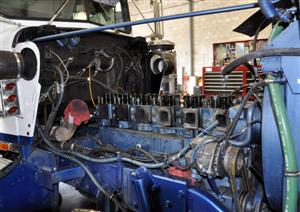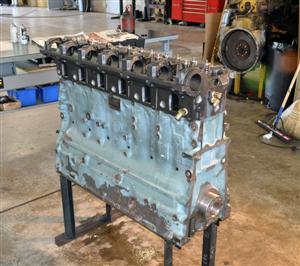August 2009 - Performance Zone
ENGINE REBUILD OPTIONS
By Performance Specialist Bruce C. Mallinson
There seems to be a lot of confusion in the trucking industry pertaining to in-chassis engine rebuilding versus out-of-chassis engine rebuilding. I thought that it would be a good idea to go over what we typically do during each of these different types of rebuilds. Basically, an “in-chassis” rebuild means that the engine stays bolted to the engine mounts in the chassis of the truck during the rebuild, while “out-of-chassis” means that the engine is removed from the truck and rebuilt on an engine stand on the shop floor. These rebuilds are very similar, but the out-of-chassis rebuild is much more thorough.
During an in-chassis rebuild, the engine is dissembled and cleaned, and then the old parts are inspected to identify what wore out and why. The block and upper counter bores are inspected for cracks, and the upper counter bores are checked to determine if they are level and the liner protrusion (how far the cylinder liner protrudes above the block surface) is measured. To adjust and set the liner protrusion, we cut the upper counter bores and install brass or stainless steel shims to get just the amount we want. This is why our rebuilt engines very seldom blow head gaskets – we spend a lot of time with the upper counter bores and the liner protrusion. Ignore the factory specs when it comes to liner protrusion – they are way too low. After the upper counter bores are cut, the block is pressure-washed with cleaning
solvent to remove the cuttings.
To begin the rebuilding process, we install the main bearings, liners, pistons, connecting rods and rod bearings. Then, we install the head gasket, a remanufactured cylinder head, performance injectors, camshaft and rocker arms. We then install a ported and Jet Hot coated exhaust manifold and performance turbocharger. The front cover of the engine is reinstalled and a new crankshaft damper (made in the USA) and a Mercury-filled engine balancer (made by Balance Masters) is placed on the end of the crankshaft. Replacing the water pump, oil pump, air compressor, radiator, charge air cooler, front crank seal and front engine mounts are all optional during an in-chassis rebuild.
 Once the valves and injectors are set and adjusted, oil is added and pressurized through the engine. The coolant is then put into the radiator, along with a new water filter and some Fleetguard DCA (an additive that prevents corrosion and electrolysis). Once the engine is started for the first time, we idle it for a few minutes, check for any miss, and then reset the valves and injectors. After that, the engine is painted. Then, finally, we road test the newly-rebuilt engine.
Once the valves and injectors are set and adjusted, oil is added and pressurized through the engine. The coolant is then put into the radiator, along with a new water filter and some Fleetguard DCA (an additive that prevents corrosion and electrolysis). Once the engine is started for the first time, we idle it for a few minutes, check for any miss, and then reset the valves and injectors. After that, the engine is painted. Then, finally, we road test the newly-rebuilt engine.
For an out-of-chassis rebuild, everything that is done during an in-chassis rebuild is done, with the addition of removing the crankshaft from the block and taking the engine to a machine shop for additional work. The crankshaft is straightened, polished and magnafluxed for cracks. Most crankshafts are bent about .020 to .025 when they have 750,000 or more miles on them. The engine block is also hot tanked and then magnafluxed. The crankshaft bore is honed straight and the head gasket surface is machined to make it smooth and flat, to better hold the head gasket. Also, the connecting rods are magnafluxed and reconditioned on the crankshaft end, and new bushings are installed in the wrist pin bore. Then, the distance from the center of the crank end to the center of the wrist pin bore is measured and the wrist pin bore is machined to hold the center line distance. The connecting rod is also balanced and checked for twisting.
Moving to the cylinder head, like the block, it is also hot tanked, magnafluxed and resurfaced. After that, new valves, valve springs, retainers, keepers and valve guides are installed. The cylinder head we use costs about $300 more than a factory reman head, but all of the parts we use are new and/or better than new.
If your transmission has a million miles or more on it, you just might want to have it rebuilt while it is out of the truck. If you do, be sure to have the flywheel resurfaced and a new clutch installed, as well. With today’s high labor rates, it is more economical to do the rebuild now, because you will only have to pay for the labor once.
Once the components are returned to the shop, the engine is reassembled. With the newly-straightened crankshaft installed into the newly-honed block, it only takes one hand to turn the 400-pound crankshaft! During the assembly process, all of the components are checked, rebuilt or replaced. New engine mounts, radiator mounts and charge air cooler mounts are installed. We also send the radiator out to be checked and cleaned, or to have the core replaced with our performance core. Our core has 364 dimpled tubes for the Kenworth or Peterbilt, versus 170 to 234 straight tubes that the OEM’s use.
Obviously, you can spend a lot of money on an out-of-chassis rebuild. But once the job is complete, you are good for another million miles of high-performance trucking – and every time you look at your truck, you will have a smile on your face. Your decision is this: do you want to keep your truck for several more years or buy the new junk our OEM’s have been forced to build by our own government? The choice is yours! If you have any comments or questions, I can be reached at Pittsburgh Power in Saxonburg, PA by calling (724) 360-4080 or via e-mail at bruce@pittsburghpower.com.
